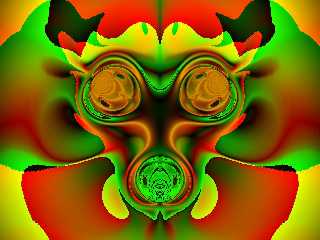 |
 |
|
 |
|
 |
|  |
|  |
|
 |
|
 |
|  |
|  |
|
 |
>> As an aside, I tried to implement this on my laptop at the weekend, but
>> it was hopelessly unstable. Today it seems very stable indeed. I can
>> only assume this is to do with replacing Euler with 4th-order
>> Runge-Kutta. I'm surprised it makes quite this much of a difference
>> though...
>
> The stability region for linear problems is a bit larger*, not to mention the
> fact that it's, well, fourth order.
I still don't really comprehend why RK4 is different to just integrating
in smaller steps. (That's all the algorithm appears to do.) But hey,
whatever.
> Of course gravitation has ugly
> singularities, so it usually just seems to be the case that it doesn't blow up
> as badly as Euler near singularities.
I've removed the singularities. They make the thing wildly unstable no
matter what integration method you use.
Even so, with Euler I couldn't make it stable, no matter how tiny I set
the integration steps. (I mean, I was approaching the limit of
machine-precision arithmetic with how tiny the steps were.) RK4 manages
apparently total stability with really quite large integration steps,
which is puzzling.
> There are much more robust methods, though:
>
> http://tableau.stanford.edu/~mwest/group/Variational_Integrators
> http://tableau.stanford.edu/~mwest/full_text/LeMaOrWe2004.pdf
>
> * http://www.scholarpedia.org/article/Runge-Kutta_methods#Stability
Heh. If I understood any of that, maybe I'd agree with you. ;-)
Post a reply to this message
|
 |
|  |
|  |
|
 |
|
 |
|  |
|  |
|
 |
Naughty boy. You've been doing a little bit too much acid. ;-)
Post a reply to this message
Attachments:
Download 'frame0039.jpg' (53 KB)
Preview of image 'frame0039.jpg'

|
 |
|  |
|  |
|
 |
|
 |
|  |
|  |
|
 |
Kevin Wampler wrote:
> I think you may have some misconceptions about what chaos is. First
> off, sensitivity to initial conditions is a necessary but *not
> sufficient* condition for chaotic behavior.
According to Wikipedia (which is never wrong), a chaotic system must
possess three attributes:
1. Sensitive dependence on initial conditions.
2. Topologically mixing.
3. Its periodic orbits are dense.
I know the system has property #1. I believe it has property #2. I have
no idea WTF #3 even *means*.
> Thirdly, although it's possible I'm wrong here, if you have *any*
> dampening I don't think the system can be counted as chaotic because all
> paths will eventually converge to a point.
According to Wikipedia, the important thing is that the orbits have
"significantly different" behaviour. (And apparently what you define as
"significant" can affect what counts as chaos.)
> Finally, I'm not sure that your system is chaotic. For inverse-square
> springs it's known as Euler's three-body problem and appears to have a
> (rather complicated) analytic solution.
Well, maybe...
Post a reply to this message
|
 |
|  |
|  |
|
 |
|
 |
|  |
|  |
|
 |
Pop quiz: The image shows signs of instability. (Those raggid edges are
probably supposed to be perfect curves.) How do I solve this?
1. Decrease the maximum time step size?
2. Decrease the minimum time step size?
3. Decrease the maximum error bound?
Answers on a postcard. ;-)
Post a reply to this message
|
 |
|  |
|  |
|
 |
|
 |
|  |
|  |
|
 |
Now with 2x supersampling antialias - and a lot less JPEG compression...
Post a reply to this message
Attachments:
Download 'frame0039.jpg' (95 KB)
Preview of image 'frame0039.jpg'

|
 |
|  |
|  |
|
 |
|
 |
|  |
|  |
|
 |
Invisible wrote:
> Pop quiz: The image shows signs of instability. (Those raggid edges are
> probably supposed to be perfect curves.) How do I solve this?
>
> 1. Decrease the maximum time step size?
> 2. Decrease the minimum time step size?
> 3. Decrease the maximum error bound?
>
> Answers on a postcard. ;-)
Well, #1 is unlikely to have an effect. The operative question, though,
is whether the minimum time step size is actually being reached or not.
I don't have an answer to that question, but I just reduced the maximum
error bound ten-fold, and suddenly the images seem significantly less
"noisy".
Post a reply to this message
|
 |
|  |
|  |
|
 |
|
 |
|  |
|  |
|
 |
...and now with max_error = 0.001
Post a reply to this message
Attachments:
Download 'frame0039.jpg' (91 KB)
Preview of image 'frame0039.jpg'

|
 |
|  |
|  |
|
 |
|
 |
|  |
|  |
|
 |
Invisible wrote:
> Invisible wrote:
Insanity? What's the first sign of madness??
Post a reply to this message
|
 |
|  |
|  |
|
 |
|
 |
|  |
|  |
|
 |
Weee... I think I might have to Zazzle some of these when I got the
program working smoothly. ;-)
I could stare at this for quite some time. (Especially if it was at a
decent resolution.) But nothing compares to seeing it move! ;-)
Post a reply to this message
Attachments:
Download 'frame0062.jpg' (389 KB)
Preview of image 'frame0062.jpg'

|
 |
|  |
|  |
|
 |
|
 |
|  |
|  |
|
 |
Invisible wrote:
> According to Wikipedia (which is never wrong), a chaotic system must
> possess three attributes:
>
> 1. Sensitive dependence on initial conditions.
> 2. Topologically mixing.
> 3. Its periodic orbits are dense.
>
> I know the system has property #1. I believe it has property #2. I have
> no idea WTF #3 even *means*.
Basically it means that there are infinitely many periodic solutions as
well as the non-repeating ones, which I'm pretty sure is true of this
system. I was more just pointing out that your assertion a few posts
back "chaos if arbitrarily close starting points diverge violently" was
incomplete.
Note that this is *total* nit-picking on my part, I know that you
intuitively understand what chaos is.
>> Thirdly, although it's possible I'm wrong here, if you have *any*
>> dampening I don't think the system can be counted as chaotic because
>> all paths will eventually converge to a point.
>
> According to Wikipedia, the important thing is that the orbits have
> "significantly different" behaviour. (And apparently what you define as
> "significant" can affect what counts as chaos.)
I can believe this, and certainly it's fine to call the dampened system
chaotic since everyone will know what you mean. I think (without proof)
that the issue is that a dampened system doesn't actually display
sensitivity conditions in that points which are close enough will be
sucked into one of the attractors before they can diverge. Of course,
this distance will probably shrink exponentially and you increase the
dampening half-life so it'll be below numerical precision pretty quickly.
>> Finally, I'm not sure that your system is chaotic. For inverse-square
>> springs it's known as Euler's three-body problem and appears to have a
>> (rather complicated) analytic solution.
>
> Well, maybe...
I'm actually way less sure than I used to be on this. This is
extra-interesting, as I wasn't aware that it was possible to
analytically solve a chaotic ODE at all.
Reading back, my email comes off as more snarkey than I intended.
Basically what I mean to convey is that there's a whole large and
interesting mathematical theory of chaos beyond one's intuitive
understanding of it, and it strikes me like the sort of thing you might
be interested in.
Post a reply to this message
|
 |
|  |
|  |
|
 |
|
 |
|  |




![]()